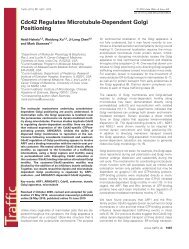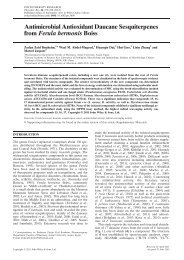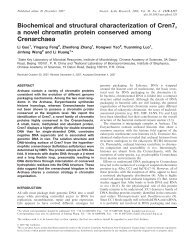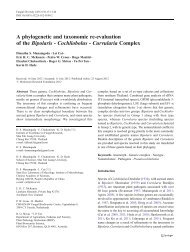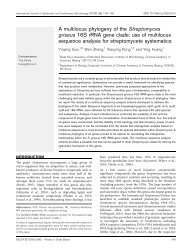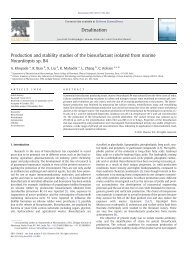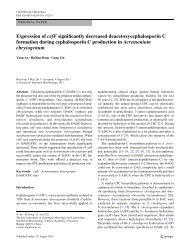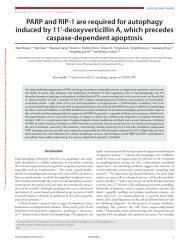Purification and characterization of four keratinases ... - ResearchGate
Purification and characterization of four keratinases ... - ResearchGate
Purification and characterization of four keratinases ... - ResearchGate
You also want an ePaper? Increase the reach of your titles
YUMPU automatically turns print PDFs into web optimized ePapers that Google loves.
F. Xie et al. / Bioresource Technology 101 (2010) 344–350 347<br />
Concentrated culture<br />
Sephacryl S-200<br />
Peak I<br />
DEAE FF<br />
Peak II<br />
DEAE FF<br />
Peak III<br />
Peak IV<br />
Octyl FF<br />
Octyl FF<br />
Octyl FF<br />
KI<br />
KII<br />
KIII<br />
KIV<br />
Fig. 2. <strong>Purification</strong> strategy for extracting <strong>keratinases</strong> from Streptomyces sp. strain 16.<br />
kDa<br />
110<br />
M<br />
1 2 3 4<br />
Table 1<br />
Activity determination in different components treated by ultrafiltration.<br />
1 2 3<br />
66<br />
Protein (lg/ml) 244 256 1.5<br />
Keratinolytic activity (U/ml) 37 42 0<br />
Specific activity (U/mg protein) 151.6 164.1 0<br />
45<br />
35<br />
1. The retentate by 100 kDa ultrafiltration.<br />
2. The retentate by 10 kDa ultrafiltration.<br />
3. Filtrate by 10 kDa ultrafiltration.<br />
25<br />
18<br />
14<br />
Fig. 3. SDS–PAGE analysis <strong>of</strong> the purified <strong>keratinases</strong> (KI, KII, KIII, <strong>and</strong> KIV)<br />
produced by Streptomyces sp. strain 16. The molecular marker, KI, KII, KIII, <strong>and</strong> KIV<br />
are located in lane M, 1, 2, 3, <strong>and</strong> 4, respectively.<br />
Superose 12 10/300 GL column. The results provided a molecular<br />
weight estimate <strong>of</strong> 203.2 kDa for KI, 100.8 kDa for KII, 31.8 kDa<br />
for KIII, <strong>and</strong> 19.2 kDa for KIV. This indicated that KI is a homo-octamer,<br />
KII a homo-dimer, <strong>and</strong> KIII a monomer <strong>and</strong> KIV a monomer.<br />
To further verify that KI is an active homo-octomer, ultrafiltration<br />
was conducted. Retentate with a molecular weight <strong>of</strong> 100 kDa,<br />
retentate with a molecular weight <strong>of</strong> 10 kDa, <strong>and</strong> filtrate with a<br />
molecular weight <strong>of</strong> 10 kDa or less were sequentially collected<br />
<strong>and</strong> analyzed (Table 1). Most <strong>of</strong> the enzyme activity was detected<br />
in retentate with a molecular weight <strong>of</strong> 100 kDa <strong>and</strong> a molecular<br />
weight <strong>of</strong> 10 kDa. However, no activity emerged in the filtrate with<br />
a molecular weight <strong>of</strong> 10 kDa.<br />
3.3. Influence <strong>of</strong> temperature <strong>and</strong> pH on the keratinolytic activity <strong>of</strong> KI,<br />
KII, KIII, <strong>and</strong> KIV<br />
The <strong>four</strong> purified <strong>keratinases</strong> had high activities between pH 8.0<br />
<strong>and</strong> 10.0, with maximal activity at pH 9.0. The <strong>four</strong> <strong>keratinases</strong><br />
showed low activities at pH 6.0 <strong>and</strong> 12.0. The effect <strong>of</strong> pH 7.0 on<br />
each <strong>of</strong> the <strong>four</strong> <strong>keratinases</strong> was different, the keratinase activities<br />
for KI <strong>and</strong> KIV were more than 50% <strong>of</strong> their maximal activities, but<br />
KII <strong>and</strong> KIII activities were less than 30% <strong>of</strong> their maximal activities.<br />
At pH 11.0, KI showed low keratinase activity, while KII, KIII, <strong>and</strong><br />
KIV showed more than 50% <strong>of</strong> their maximal activities. The <strong>four</strong><br />
<strong>keratinases</strong> showed the same pH stability. More than 85% <strong>of</strong> the<br />
maximal activities were retained between pH 8.0 <strong>and</strong> 10.0.<br />
The optimal temperature for <strong>keratinases</strong> KI, KII, <strong>and</strong> KIII was<br />
about 50 °C, while the optimal temperature was about 60 °C for<br />
keratinase KIV. KI, KII, <strong>and</strong> KIII activity dropped fast at temperatures<br />
below 40 °C <strong>and</strong> above 60 °C. For KIV, the activity at 80 °C<br />
was approximately half <strong>of</strong> its maximal activity, which was at<br />
60 °C. All <strong>four</strong> <strong>keratinases</strong> retained more than 70% <strong>of</strong> their maximal<br />
activities in the temperature range <strong>of</strong> 40–60 °C after 1 h incubation.<br />
KIV was more stable than the other three <strong>keratinases</strong>.<br />
3.4. Effects <strong>of</strong> chemicals on keratinolytic activities <strong>of</strong> KI, KII, KIII <strong>and</strong><br />
KIV<br />
Protease inhibitors, reducing agents, <strong>and</strong> metal ions were used<br />
to investigate their effects on the enzyme activities (Table 2). All<br />
<strong>four</strong> enzymes were significantly inhibited by the serine protease<br />
inhibitor PMSF at 1 mM. This indicates that all <strong>of</strong> the enzymes belong<br />
to the serine protease family. Moreover, the residual activities<br />
<strong>of</strong> the <strong>four</strong> enzymes were evidently not affected by cysteine protease<br />
inhibitor pCMB. However, metalloprotease inhibitor EDTA<br />
strongly inhibited KI, KII, <strong>and</strong> KIII, although it did not inhibit the<br />
activity <strong>of</strong> KIV. For all <strong>four</strong> <strong>keratinases</strong>, significant increases in keratinolytic<br />
activity were observed by adding reducing agents DTT,<br />
ascorbic acid, <strong>and</strong> sodium sulfite. Carbonyl group modifier EDAC<br />
had stimulative effects on the activities <strong>of</strong> KI, KIII, <strong>and</strong> KIV. The keratinolytic<br />
activities <strong>of</strong> KI, KIII, <strong>and</strong> KIV increased by 36%, 100%, <strong>and</strong><br />
32%, respectively. The divalent metal ion Ca 2+ showed a stimulative





